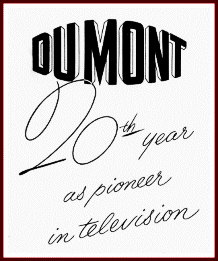Thursday, November 7, 2002
Page 22
REMINISCING (Column)
Allen B. Du Mont, Scientist
By ROGER M. GRACE
The Du Mont television network—with which Los Angeles television Channels 2, then 11, and, in the end, 9 were affiliated—was founded not by an entrepreneur but by a scientist. He was Allen B. Du Mont, inventor of the first commercially practical cathode ray tube (CRT)—that is, the picture tube in TV sets (now also used in computers).
Born January 29, 1901, in Brooklyn, Du Mont was stricken by polio when he was 11, and spent about a year in bed. His father bought him a radio. He studied it; learned the principles of radio; and built his own.
Du Mont earned his Bachelor of Science degree from Rensselaer Polytechnic Institute in New York in 1924, majoring in electronic engineering. He went to work for the Westinghouse Lamp Company which made radio tubes, becoming the engineer in charge of production. Four years later, he got a job with Lee De Forest, serving as chief engineer and vice president of De Forest Radio Company, at first concerned with radio development, later with experimentation in television. In 1931, he founded his own company, Allen B. Du Mont Laboratories, operating on a shoestring out of his garage.
 Just as Edison did not invent the
light bulb—bulbs existed, but would burn out quickly, unlike Edison’s brainchild—Du Mont did not invent the
cathode ray tube (the creation of a German scientist in 1897). But Du Mont did figure out how to
make it durable. His tubes lasted thousands of hours and could be produced
cheaply, while the predecessor bulbs, manufactured in Germany, lasted only 25-30
hours, and were expensive. Ironically, the three national television networks
which outlasted Du Mont’s could not have come
into existence had it not been for Du Mont’s cathode tube rendering the television set a
marketable device.
Just as Edison did not invent the
light bulb—bulbs existed, but would burn out quickly, unlike Edison’s brainchild—Du Mont did not invent the
cathode ray tube (the creation of a German scientist in 1897). But Du Mont did figure out how to
make it durable. His tubes lasted thousands of hours and could be produced
cheaply, while the predecessor bulbs, manufactured in Germany, lasted only 25-30
hours, and were expensive. Ironically, the three national television networks
which outlasted Du Mont’s could not have come
into existence had it not been for Du Mont’s cathode tube rendering the television set a
marketable device.
A previous column told of how Don Lee’s experimental station in Los Angeles, W6XAO, sent diagrams to would-be television viewers (then dubbed “lookers”) in the 1930s, so they could build their own sets. It was Du Mont’s company that was apparently the first to put TV sets on the market in a meaningful effort. That was in 1938. Its sets, through the years, were the best—but by the early 1950s, sets of lesser quality, that were cheaper, became more popular.
Branching out, Du Mont became a broadcaster. In 1941, he founded experimental television station W2XWV in New York which, when it soon after became a commercial station, took on the call letters WABD— “ABD” standing for Allen B. Du Mont.
During World War II, television expansion was on hold; after the war, Du Mont started experimental station W3XWT in the District of Columbia which, in November 1946, became WTTG. It was when WABD and WTTG were electronically linked in 1946 that the Du Mont network was formed, and embarked on head-on-head competition with RCA’s NBC.
